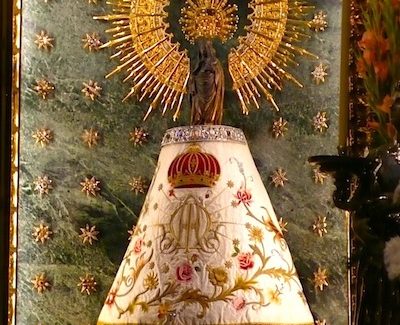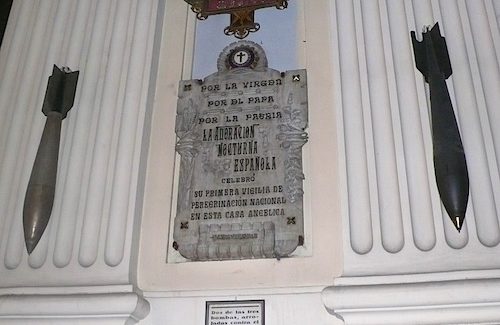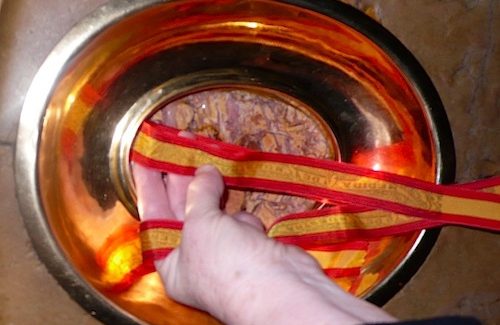Basilica Honors Patron Saint
During the Spanish Civil War, three bombs fell on the Basilica del Pilar in Zaragoza, Spain. Two bombs went through the ceiling. Another landed just outside the church. None exploded.
“It may have been a stroke of luck,” said local guide Benoit. “That is a plausible theory.”
Another theory says that it was a miracle.
Today the defused bombs are displayed on a wall inside the basilica. Inside are also priceless art works, including two frescoes by Goya and a pillar believed to be one of the most important religious artifacts in Catholicism.
“Some people believe the pillar sustains Christianity while others believe it is the axis around which Christianity turns,” Benoit said.
Whatever the reason, the basilica was full of people when I stopped in during a recent visit to Zaragoza, Spain. Some people were probably tourists, some were pilgrims, some worshippers who visit the cathedral every day.
They light candles, participate in mass, kneel to kiss the pillar and slip a euro into a box to buy a commemorative ribbon.
“For some, they come here every day for comfort,” Benoit said. “The Virgin of the Pillar is very popular for people of Spain. She is the patron saint not only of Aragon but also of the whole of Spain and Spanish-speaking people everywhere.”
More than 20 flags representing countries from the Spanish-speaking community decorate the walls of the basilica. “The American flag was placed here in 2002,” Benoit said.
Legend of the Apostle James
According to legend, the Apostle James was in Zaragoza preaching Christianity to the largely pagan country in the year 40 A.D.
“He was feeling discouraged so the Virgin Mary came to comfort and console him,” Benoit said. “To show that she had been here, she left a pillar made of jasper.”
The pillar was to be used as the base for a chapel to be built on the very spot where Mary talked with James. It became the first Marian temple in the Christian world.
Standing on the banks of the Ebro River in Zaragoza, the temple has grown during 20 centuries without moving the site of the column. “Where it is, is where it originally was,” Benoit said.
The first temple was quite simple. The present cathedral – built mainly between 1681 and 1872 – is a jewel of Aragonese Baroque art.
“The building of the church took so long – more than 200 years – that there’s a saying in Zaragoza for things that take ages to be done: ‘It takes longer than the building of El Pilar,’” Benoit said.
The cathedral is huge, the dominant feature on the sprawling plaza in the heart of Zaragoza. With its fairytale spires and colorfully tiled roofs – it has 11 domes – the basilica is a work of art from any angle. Ascend to the top of one of the towers for a panoramic view of the city.
Cloaks for the Virgin of the Pillar
The focal point of the basilica is a small statute of the Virgin Mary atop the ancient pillar. Covered with silver, the pillar is draped each day with a different ornate cloak – gifts from the faithful and the grateful, including several from Popes.
A small museum at the cathedral showcases some of the cloaks and jewelry given to the Virgin Mary, along with paintings and sketches considered to be among the most important examples of 17th century Spanish Baroque art.
“The Virgin of the Pillar has 400 or 500 cloaks,” Benoit said. “A bullfighter whose life was saved not long ago gave a beautiful one.”
Three times a month the pillar can be seen without a cloak. “On the second, the 12th and the 20th of the month, it doesn’t have a cloak,” Benoit said.
Those dates are in honor of Jan. 2 – when Mary appeared to the Apostle in 40 AD, for Oct. 12 – the Festival of the Virgin, and for May 20 – the crowning of the Virgin by the Vatican on May 20, 1905.
Lore says that many miracles have occurred in the basilica. One of the most unusual involves a young man from a nearby village who lost his leg. Born in 1617, Miguel Pellicer was 19 years old when he fell beneath a cart while he was working. His right leg was severely damaged and gangrene set in. The leg was amputated and buried outside the hospital.
No longer able to work, Pellicer became a beggar and a regular fixture at the basilica. Each day he would pray to the Virgin Mary for saving his life and would rub the used oil from the church lamps on the painful stump of his leg. Two years and five months after the accident, Pellicer went home to visit his parents when the Miracle of Calanda occurred.
“He was asleep when his family noticed that two feet were sticking out from beneath the blankets,” Benoit said. “His leg had grown back again through a miracle.”
And it was the original leg, the tale continues. Marks from his accident, as well as scars from a childhood dog bite on his calf could be seen. Striking paintings recall that story.
Tradition of Kissing the Pillar
A tradition at the basilica is to kiss the pillar. A place has been left open behind the altar where centuries of kneelers and kisses have left a deep gouge in the stone and a slope in the marble step. It has also become customary to buy a ribbon and rub it against the pillar.
“Some people wear the ribbons on their wrists, some tie it around the rearview mirror in their car for blessings and protection,” Benoit said. “It is a good way of financing the church and keeping tradition alive.”
Each year around Oct. 12, nearly a million people are attracted to Zaragoza for the nine-day Feast of Our Lady of the Pillar.
“More than 400,000 people dressed in traditional costume came to offer flowers to the virgin on Oct. 12,” Benoit said.
“Some people do not go to church but they do believe in the Virgin of the Pillar,” Benoit said. “It is a mixture of tradition and religion.”
Story and Photos by Jackie Sheckler Finch


















View Recent Comments